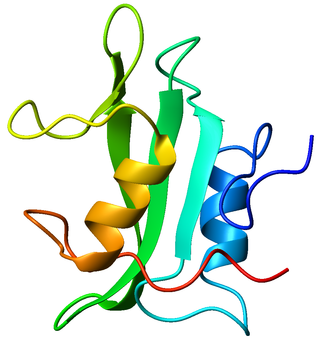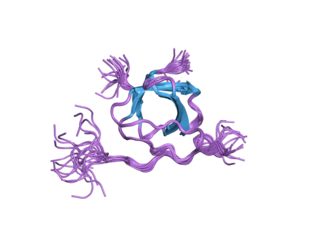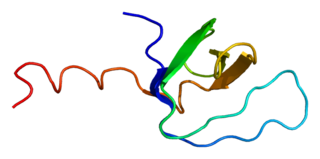Tyrosine-protein kinase SYK, also known as spleen tyrosine kinase, is an enzyme which in humans is encoded by the SYK gene. [5] [6] [7]
Tyrosine-protein kinase SYK, also known as spleen tyrosine kinase, is an enzyme which in humans is encoded by the SYK gene. [5] [6] [7]
SYK, along with ZAP70, is a member of the Syk family of tyrosine kinases. These cytoplasmic non-receptor tyrosine kinases share a characteristic dual SH2 domain separated by a linker domain. However, activation of SYK relies less on phosphorylation by Src family kinases than ZAP70. [8] SYK and ZAP70 share a common evolutionary origin and split from a common ancestor in the jawed vertebrates. [9]
While Syk and ZAP70 are primarily expressed in hematopoietic tissues, a variety of tissues express Syk. Within B and T cells, respectively, Syk and ZAP70 transmit signals from the B-cell receptor and T-cell receptor. [10] Syk plays a similar role in transmitting signals from a variety of cell surface receptors including CD74, Fc receptor, and integrins.
Mice that lack Syk completely (Syk−/−, Syk-knockout) die during embryonic development around midgestation. They show severe defects in the development of the lymphatic system. Normally, the lymphatic system and the blood system are strictly separated from each other. However, in Syk deficient mice the lymphatics and the blood vessels form abnormal shunts, leading to leakage of blood into the lymphatic system. The reason for this phenotype was identified by a genetic fate mapping approach, showing that Syk is expressed in myeloid cells which orchestrate the proper separation of lymphatics and blood system during embryogenesis and beyond. Thus, Syk is an essential regulator of the lymphatic system development in mice. [11]
Abnormal function of Syk has been implicated in several instances of hematopoietic malignancies including translocations involving Itk and Tel. Constitutive Syk activity can transform B cells. Several transforming viruses contain "Immunoreceptor Tyrosine Activation Motifs" (ITAMs) which lead to activation of Syk including Epstein–Barr virus, bovine leukemia virus, and mouse mammary tumor virus.
Given the central role of SYK in transmission of activating signals within B-cells, a suppression of this tyrosine kinase might aid in the treatment of B cell malignancies and autoimmune diseases.[ citation needed ]
Syk inhibition has been proposed as a therapy for both lymphoma and chronic lymphocytic leukemia.[ citation needed ] Syk inhibitors are in clinical development, including cerdulatinib and entospletinib. [12] Other inhibitors of B-cell receptor (BCR) signaling including ibrutinib (PCI-32765) which inhibits BTK, [13] and idelalisib (PI3K inhibitor - CAL-101 / GS-1101) showed activity in the diseases as well. [14]
The orally active SYK inhibitor fostamatinib (R788) in the treatment of immune thrombocytopenia. [15]
The Syk inhibitor nilvadipine has been shown to regulate amyloid-β production and Tau phosphorylation and hence has been proposed as a treatment for Alzheimer's disease [16] and has entered phase III clinical trials. [17]
The role of Syk in epithelial malignancies is controversial. Several authors have suggested that abnormal Syk function facilitates transformation in Nasopharyngeal carcinoma and head and neck cancer while other authors have suggested a tumor suppressor role in breast and gastric cancer.
Without Syk, the protein it makes, and genetic disruption in a panel of 55 genes thought also to be controlled by Syk, breast ductal carcinoma in situ (breast DCIS, which can become invasive), it is believed that the cancer has a markedly increased tendency to invade and metastasize. [18]
Syk has been shown to interact with:

Lck is a 56 kDa protein that is found inside specialized cells of the immune system called lymphocytes. The Lck is a member of Src kinase family (SFK), it is important for the activation of the T-cell receptor signaling in both naive T cells and effector T cells. The role of the Lck is less prominent in the activation or in the maintenance of memory CD8 T cells in comparison to CD4 T cells. In addition, the role of the lck varies among the memory T cells subsets. It seems that in mice, in the effector memory T cells (TEM) population, more than 50% of lck is present in a constitutively active conformation, whereas, only less than 20% of lck is present as active form of lck. These differences are due to differential regulation by SH2 domain–containing phosphatase-1 (Shp-1) and C-terminal Src kinase.

Growth factor receptor-bound protein 2, also known as Grb2, is an adaptor protein involved in signal transduction/cell communication. In humans, the GRB2 protein is encoded by the GRB2 gene.

ZAP-70 is a protein normally expressed near the surface membrane of lymphocytes. It is most prominently known to be recruited upon antigen binding to the T cell receptor (TCR), and it plays a critical role in T cell signaling.

Lymphocyte cytosolic protein 2, also known as LCP2 or SLP-76, is a signal-transducing adaptor protein expressed in T cells and myeloid cells and is important in the signaling of T-cell receptors (TCRs). As an adaptor protein, SLP-76 does not have catalytic functions, primarily binding other signaling proteins to form larger signaling complexes. It is a key component of the signaling pathways of receptors with immunoreceptor tyrosine-based activation motifs (ITAMs) such as T-cell receptors, its precursors, and receptors for the Fc regions of certain antibodies. SLP-76 is expressed in T-cells and related lymphocytes like natural killer cells.

The Linker for activation of T cells, also known as linker of activated T cells or LAT, is a protein involved in the T-cell antigen receptor signal transduction pathway which in humans is encoded by the LAT gene. Alternative splicing results in multiple transcript variants encoding different isoforms.

Non-receptor tyrosine-protein kinase TYK2 is an enzyme that in humans is encoded by the TYK2 gene.

Proto-oncogene tyrosine-protein kinase Fyn is an enzyme that in humans is encoded by the FYN gene.

Tyrosine-protein kinase Lyn is a protein that in humans is encoded by the LYN gene.

Phosphatidylinositol 3-kinase regulatory subunit alpha is an enzyme that in humans is encoded by the PIK3R1 gene.

PTK2 protein tyrosine kinase 2 (PTK2), also known as focal adhesion kinase (FAK), is a protein that, in humans, is encoded by the PTK2 gene. PTK2 is a focal adhesion-associated protein kinase involved in cellular adhesion and spreading processes. It has been shown that when FAK was blocked, breast cancer cells became less metastatic due to decreased mobility.

Cbl is a mammalian gene encoding the protein CBL which is an E3 ubiquitin-protein ligase involved in cell signalling and protein ubiquitination. Mutations to this gene have been implicated in a number of human cancers, particularly acute myeloid leukaemia.

Crk-like protein is a protein that in humans is encoded by the CRKL gene.

Protein tyrosine kinase 2 beta is an enzyme that in humans is encoded by the PTK2B gene.

Rap guanine nucleotide exchange factor 1 is a protein that in humans is encoded by the RAPGEF1 gene.

CBL-B is an E3 ubiquitin-protein ligase that in humans is encoded by the CBLB gene. CBLB is a member of the CBL gene family.

Proto-oncogene vav is a protein that in humans is encoded by the VAV1 gene.

Protein tyrosine phosphatase non-receptor type 22 (PTPN22) is a cytoplasmatic protein encoded by gene PTPN22 and a member of PEST family of protein tyrosine phosphatases. This protein is also called "PEST-domain Enriched Phosphatase" ("PEP") or "Lymphoid phosphatase" ("LYP"). The name LYP is used strictly for the human protein encoded by PTPN22, but the name PEP is used only for its mouse homolog. However, both proteins have similar biological functions and show 70% identity in amino acid sequence. PTPN22 functions as a negative regulator of T cell receptor (TCR) signaling, which maintains homeostasis of T cell compartment.

Tyrosine-protein kinase Tec is a tyrosine kinase that in humans is encoded by the TEC gene. Tec kinase is expressed in hematopoietic, liver, and kidney cells and plays an important role in T-helper cell processes. Tec kinase is the name-giving member of the Tec kinase family, a family of non-receptor protein-tyrosine kinases.

B-cell linker (BLNK) protein is expressed in B cells and macrophages and plays a large role in B cell receptor signaling. Like all adaptor proteins, BLNK has no known intrinsic enzymatic activity. Its function is to temporally and spatially coordinate and regulate downstream signaling effectors in B cell receptor (BCR) signaling, which is important in B cell development. Binding of these downstream effectors is dependent on BLNK phosphorylation. BLNK is encoded by the BLNK gene and is also known as SLP-65, BASH, and BCA.
A non-receptor tyrosine kinase (nRTK) is a cytosolic enzyme that is responsible for catalysing the transfer of a phosphate group from a nucleoside triphosphate donor, such as ATP, to tyrosine residues in proteins. Non-receptor tyrosine kinases are a subgroup of protein family tyrosine kinases, enzymes that can transfer the phosphate group from ATP to a tyrosine residue of a protein (phosphorylation). These enzymes regulate many cellular functions by switching on or switching off other enzymes in a cell.